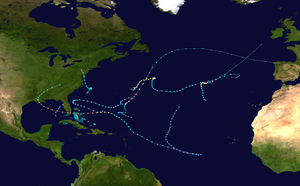| 1992 Atlantic hurricane season | |
|---|---|
 Season summary map | |
| Seasonal boundaries | |
| First system formed | April 21, 1992 |
| Last system dissipated | October 27, 1992 |
| Strongest storm | |
| Name | Andrew |
| • Maximum winds | 175 mph (280 km/h) (1-minute sustained) |
| • Lowest pressure | 922 mbar (hPa; 27.23 inHg) |
| Seasonal statistics | |
| Total depressions | 10 |
| Total storms | 6 |
| Hurricanes | 4 |
| Major hurricanes (Cat. 3+) | 1 |
| Total fatalities | 73 total |
| Total damage | $27.302 billion (1992 USD) |
| Related articles | |
The 1992 Atlantic hurricane season was a significantly below average season for overall tropical or subtropical cyclones as only ten formed. Six of them became named tropical storms, and four of those became hurricanes; one hurricane became a major hurricane (Category 3 to 5 strength on the Saffir–Simpson scale). The season was, however, near-average in terms of accumulated cyclone energy. The season officially started on June 1 and officially ended on November 30. However, tropical cyclogenesis is possible at any time of the year, as demonstrated by formation in April of an unnamed subtropical storm in the central Atlantic.
In June, Tropical Depression One caused flooding in Cuba and in Florida, where two people were killed. In August, Hurricane Andrew, the season's only major hurricane, struck the Bahamas, Florida, and Louisiana. It was the costliest Atlantic hurricane on record at the time, caused $27.3 billion (1992 USD) in damage; it also caused as 65 fatalities. Its greatest impact was in South Florida, where the storm made landfall with 1-minute sustained winds of 175 mph (280 km/h).
One month later, Hurricanes Bonnie and Charley produced tropical storm-force winds in the Azores, and the former caused one fatality. Tropical Storm Danielle was one of few tropical cyclones known to make landfall on the Delmarva Peninsula. The storm caused minor damage and two fatalities in the Mid-Atlantic and New England regions of the United States. One other hurricane in the season, Frances, did not significantly affect land. It developed in the central Atlantic, and tracked well away from land, and brought only light rainfall to Newfoundland. Collectively, the storms in the 1992 Atlantic hurricane season caused $27.3 billion in losses and 73 fatalities.